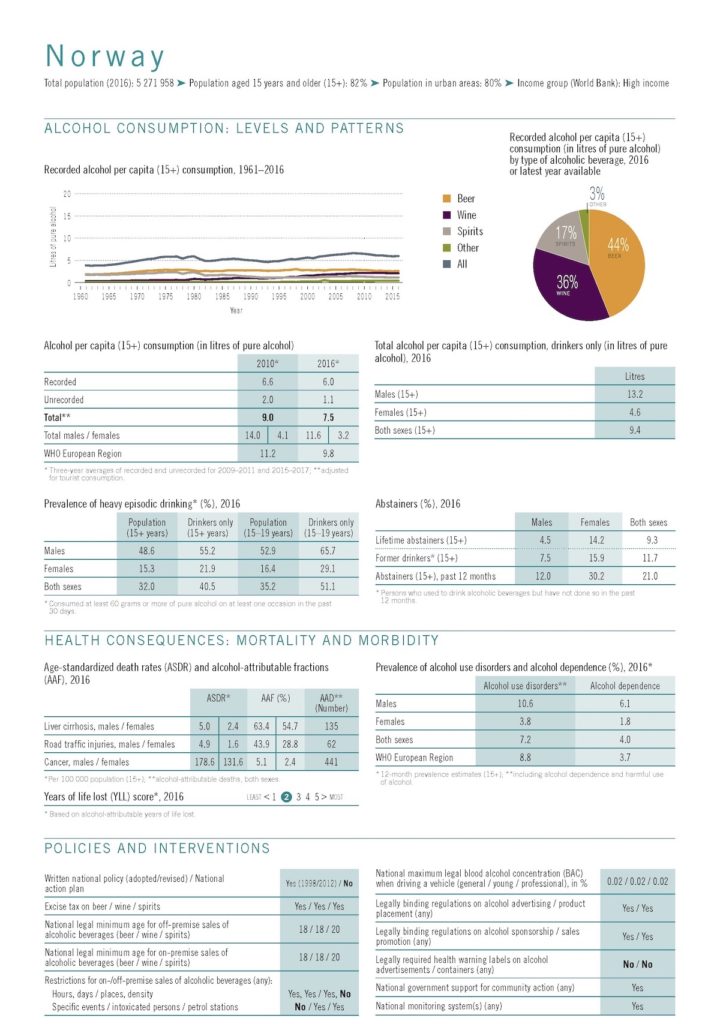Oslo Economics calculated the costs caused by the products and practices of the alcohol industry to Norwegian society. They report that the harm caused by the alcohol industry costs Norway between 80 to 100 billion Norwegian kroner ($9 to $11 billion) annually. This is a staggering figure. For context, the annual costs of alcohol harm in Norway amount to the cost of three Winter Olympics in Beijing 2022.
The study was commissioned by Actis, the Norwegian Policy Network on Alcohol and Drugs is an umbrella organization for NGOs in the alcohol and other drugs field. Actis represents 34 different organisations that work to prevent and reduce harm caused by alcohol, other drugs and gambling.
Reducing alcohol consumption provides a great financial gain,” said Inger Lise Hansen, Secretary-General of Actis, as per Accent.
The report shows that it is far cheaper to prevent alcohol harm through an evidence-based alcohol policy than to pay the price for high population-level alcohol consumption afterward.”
Inger Lise Hansen, Secretary-General, Actis
Breakdown of the alcohol costs
The products and practices of the alcohol industry cause massive costs to Norwegian society. The costs can be distinguished in four categories (in NOK):
- 68-77 billion – deteriorating health and quality of life,
- 10–13 billion – sick leave and reduced productivity,
- 1.4–7 billion – healthcare and social services, and
- 1.5–4 billion – resources from other sectors of society.
Out of the NOK 68-77 billion costs relating to deteriorating health and quality of life, Oslo Economics estimates that between NOK 9.2 and 17.2 billion can be attributed to relatives.
We must bear in mind that behind these figures are people who today pay a high price for our [alcohol use] pattern,” added Inger Lise Hansen, as per Accent.
Reduced alcohol consumption can reduce government spending. For individuals, it can ease the burden and provide fewer worries and increased quality of life. My message is we must prevent.”
Inger Lise Hansen, Secretary-General, Actis
Alcohol harm and policy in Norway
The World Health Organization reports that the total per capita alcohol consumption in Norway is 7.5 liters (in 2016). While this is below the average of the WHO European region there is still cause for concern. Among young people between 15 to 19 years who consume alcohol about half (51.1%) engage in binge alcohol use. This is despite the legal age for alcohol sales being 18 years (for beer and wine and 20 years for spirits). Meaning alcohol availability for minors remains a significant problem is Norway.
More than 10% of Norwegian men have an alcohol use disorder. More than 400 people die every year from cancer due to alcohol.
The Norwegian government aims to reduce population-level alcohol consumption by 10% by 2025. Actis says this would have wide-ranging benefits for Norwegian people and communities, including better public health, fewer alcohol-related injuries, and a better quality of life.
Norway has a comprehensive alcohol policy that encompasses the WHO’s best buys of increasing prices through alcohol taxes, reducing alcohol availability, and implementing bans on alcohol advertising, sponsorship, and promotion. The government operates the state alcohol monopoly Vinmonopolet to control alcohol prices by removing profit motives from alcohol retail.
The World Health Organization points to price, availability, and advertising bans as what works best to keep consumption down. Research also shows that it is the broad, population-oriented measures that work best to keep consumption down even among those who [use alcohol] the most,” explained Inger Lise Hansen, as per Accent.
That is why it is important to do what we can to keep Vinmonopolet, keep taxes high and protect the advertising ban.”
Inger Lise Hansen, Secretary-General, Actis

